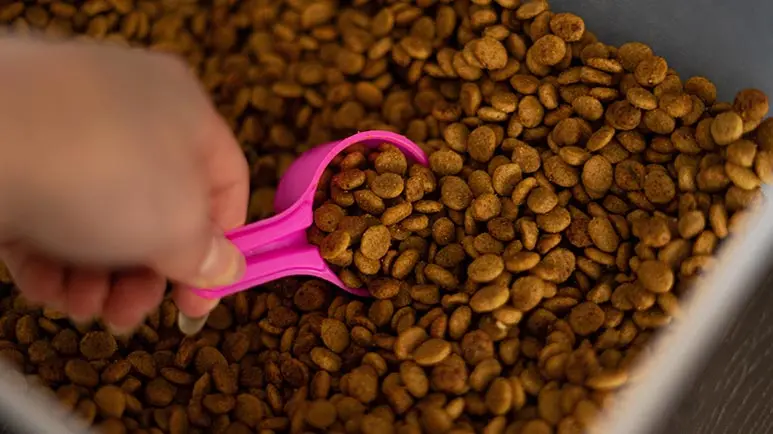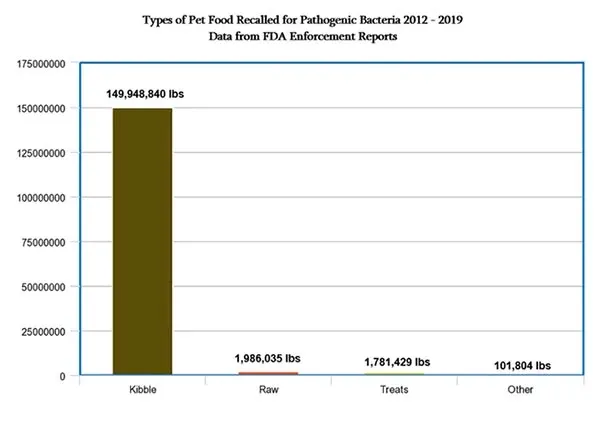Is Your Dog's Dry Food Putting Your Family at Risk?
Every scoop of kibble you feed your pet could be contaminated with this type of pathogenic bacteria. Find out how to keep yourself and your family safe.

STORY AT-A-GLANCE
- In late 2023, an FDA report linked seven human salmonella cases to dry pet food from Mid America Pet Food, leading to a recall of multiple brands and products
- Ironically, dry kibble poses a greater risk of salmonella contamination. Historical data shows kibble is responsible for about 80% of pet food recalls, with pathogenic bacteria like salmonella being the leading cause of these recalls since 2012
- While pets can naturally harbor salmonella, it's more dangerous for humans, causing severe food poisoning. Handling kibble poses a higher contamination risk than raw meat diets
- Kibble has additional drawbacks, including rancid fats, mycotoxins, and questionable ingredient sources. Experts recommend switching to a balanced, species-appropriate raw or gently cooked homemade diet for optimal pet nutrition
In 2019, a group of university researchers in Italy published a study1 on the top reasons why many pet parents switch to raw, meat-based diets for their animal companions. The respondents highlighted several concerns, such as lack of ingredient origin and the use of additives.
However, there’s one more crucial reason why it’s best to reconsider feeding conventional dry pet food to your pets — they harbor dangerous contaminants like salmonella that could put your and your family’s health at risk.
Salmonella Outbreak Linked to Kibble
There’s been a lot of criticism over the raw pet food movement, with processed pet food advocates claiming that feeding pets a raw diet exposes them to pathogenic bacteria found in raw meat.
But did you know that the majority of recalls involving pathogenic bacteria in the last few years actually involve kibble? Historically, pathogen contamination has been a problem attributed to processed diets, and not fresh pet food.
Case in point — In late 2023, the U.S. Food and Drug Administration (FDA), along with the U.S. Centers for Disease Control and Prevention (CDC) reported seven human cases of salmonella Kiambu infection associated with dry pet food produced by Mid America Pet Food.2,3 The affected individuals were from seven different states; six of them were children aged 1 year or younger. According to the FDA website:
“Five of these cases reported exposure to dogs and three reported feeding Victor pet food to their pets. Illnesses started on dates ranging from January 14, 2023, to August 19, 2023. One person was hospitalized, and no deaths have been reported.”4
Mid America Pet Food then voluntarily recalled all their pet food products with a best-by date of October 31, 2024, from different brands, which include Member’s Mark, Wayne Feds, Eagle Mountain and Victor.
Kibble Is the No. 1 Cause of Pet Food Recalls from Pathogenic Bacteria
As mentioned, this isn’t the first case of salmonella contamination linked to dry pet food. From 2006 to 2008, a salmonella outbreak that affected 79 people from 21 states was reported, with the source of infection traced to dry dog food from a Pennsylvania manufacturing plant.5
And in 2012, 49 people from 20 states and Canada were sickened by Salmonella infantis from a Diamond Foods production facility. Seventeen brands, equivalent to nearly 30,000 tons of dry dog and cat food, were recalled.6
According to the website Truth in Pet Food, about 80% of the total pounds of pet food products recalled were composed of kibble and treats. They also reported that:7
“Since 2012, more than 400,621,516 lbs. of pet food has been recalled. The leading cause of these pet food recalls was pathogenic bacteria (Salmonella, Listeria, E.coli), resulting in 154,064,611 lbs. of pet food recalled.”
But despite these findings, health officials are raising more red flags over raw pet food, despite reports that it is safer. Consider this graph — it’s so apparent how wide the margin is between kibble and raw food in terms of pathogenic bacteria contamination.

Salmonella Is More Dangerous for You Than Your Pet
The fact is that most dogs and cats have salmonella in their system; it is part of their gastrointestinal flora (GI), regardless of the diet they consume. Pets also naturally shed salmonella in their saliva and feces as well.
In the human body, however, salmonella is problematic; it’s a common cause of food poisoning, infecting millions every year.8 Although some people can recover without any treatments, others, especially young children, the elderly or those with compromised immune systems, can experience uncomfortable symptoms like diarrhea, abdominal cramps and fever. In some cases, the diarrhea is so severe that it requires hospitalization.
With dry pet food exposing you to the risks of salmonella, it’s crucial to rethink your pet-feeding habits. The data is clear — the risk of contaminating your family members with the average bag of dog kibble is higher compared to feeding them human-grade, raw meat.
The Problems with Dry Pet Food Go Beyond Salmonella
Many pet parents who choose to feed kibble prefer it because of its convenience — they can buy it in bulk and just pour it into their pet’s food bowl during mealtimes. But the fact is that dry food, no matter how shelf-stable it is, doesn’t store well.
When you open a bag of kibble, important dietary fats in the food immediately start to go rancid. Consuming these rancid fats on a long-term basis can negatively impact your pet’s health. What’s more, aside from salmonella, other opportunistic bacteria and mycotoxins can grow in dry pet food; the longer it’s stored, the greater the risk to your pet and anyone in the family who handles the food.
Since kibble is processed multiple times and at extremely high temperatures, all the nutrition in the food is eradicated; to compensate, manufacturers spray on a nutrient mix composed of cheap vitamins that further speed up the oxidation of the product.
While most kibble is formulated to meet the basic nutritional requirements of dogs and cats, it certainly doesn’t provide optimal nourishment for the long haul. Ingredients used in kibble are also from meat and bone meal from dubious sources; for example, cow and other livestock byproducts, diseased animals and even roadkill.
Kick the Kibble Habit
Instead of feeding kibble, refrain from feeding dry food and make the switch to a nutritionally balanced, species-appropriate diet; not only is it safer, but it also provides high-quality animal protein, moisture, healthy fats and fiber, with low to no starch content. The best choice is a raw or gently cooked homemade diet, made with fresh foods that feature a variety of nutrition, flavors and textures.
In addition, it’s best to keep these safety measures in mind to prevent contamination of salmonella for you, your family members and your pets:
- Wash your hands thoroughly before and after handling pet foods.
- Store all pet foods and treats away from your family’s food.
- Avoid preparing pet food in the same area you prepare your family’s food.
- Don’t use the same equipment or utensils (ex: bowls, scooper or measuring cups) that you use for your family’s food.
- Never put your pet on surfaces where you prepare food, such as your kitchen countertops.
- Wash your pet’s food and water bowl frequently, before and after feeding them.
- Don’t let young children touch your pet’s food or their food bowl; if they do, make sure they wash their hands thoroughly afterward.











